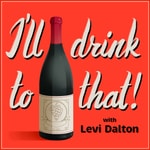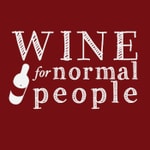I'll Drink to That! Wine Talk – Détails, épisodes et analyse
Détails du podcast
Informations techniques et générales issues du flux RSS du podcast.

I'll Drink to That! Wine Talk
Levi Dalton
Fréquence : 1 épisode/9j. Total Éps: 503

A former sommelier interviews incredibly famous and knowledgeable wine personalities in his tiny apartment. He gets them to talk candidly about their lives and work, and then shares the conversations with you. To see new episodes sooner and to see all of the hundreds of back episodes in your feed, it is important to FOLLOW or SUBSCRIBE the show. It is free to do either, the show is free.
Contact info-
Email [email protected] for advertising, consulting, speaking, or guest inquiries
Instagram @leviopenswine
Website illdrinktothatpod.com
Classements récents
Dernières positions dans les classements Apple Podcasts et Spotify.
Apple Podcasts
🇨🇦 Canada - food
29/07/2025#37🇬🇧 Grande Bretagne - food
29/07/2025#43🇺🇸 États-Unis - food
29/07/2025#51🇨🇦 Canada - food
28/07/2025#61🇺🇸 États-Unis - food
28/07/2025#52🇨🇦 Canada - food
27/07/2025#33🇺🇸 États-Unis - food
27/07/2025#50🇨🇦 Canada - food
26/07/2025#22🇺🇸 États-Unis - food
26/07/2025#47🇺🇸 États-Unis - food
25/07/2025#47
Spotify
Aucun classement récent disponible
Liens partagés entre épisodes et podcasts
Liens présents dans les descriptions d'épisodes et autres podcasts les utilisant également.
See all- https://www.bloomberg.com
8 partages
- https://www.christhile.com
5 partages
- https://www.insideburgundy.com
3 partages
Qualité et score du flux RSS
Évaluation technique de la qualité et de la structure du flux RSS.
See allScore global : 53%
Historique des publications
Répartition mensuelle des publications d'épisodes au fil des années.
500: Richard Sanford and the Hot Tub Time Machine Wine Fermenters
Épisode 500
mardi 4 juin 2024 • Durée 01:57:54
Richard Sanford co-founded the Sanford and Benedict Winery and planted the Sanford and Benedict Vineyard. He founded the Sanford Winery, and he also founded the Alma Rosa Winery, all in Santa Barbara County, California.
Richard discusses his sailing career, working in the merchant marine, racing boats recreationally, and as an officer in the United States Navy. He talks about his travels around the globe, both before and after his service in the Vietnam War. He reflects on his short time working in business and education, and then his segue to planting a vineyard in what became the Sta. Rita Hills appellation of California. That vineyard became known as the Sanford and Benedict vineyard, and Richard co-founded the Sanford and Benedict Winery with Michael Benedict to produce wine from that vineyard. They had realized that Santa Barbara County, with its transverse mountain range, offered opportunities for growing vines in areas cooled by winds coming off the Pacific Ocean.
Richard remembers his introduction to wine and a bottle of Volnay, and his desire to plant Pinot Noir in the Sanford and Benedict Vineyard. He talks about the early days getting the vineyard going, in an area where Pinot Noir had not been planted previously. He discusses the geography and geology of the place, as well as the history of ownership there. Richard recalls converting a small barn into a winemaking facility, building the fermenters, and inviting his friends to harvest the first grapes from Sanford and Benedict. He also recalls the subsequent visit from the local sheriff. Besides the attention of the police, the activity at Sanford and Benedict also drew interest from wine writer Robert Lawrence Balzer, who wrote about the wine being made near Lompoc.
Richard talks throughout this interview about both the agriculture aspect and the business side of making wine. He notes that tax write offs were an impetus for the planting of many of the vineyards in Santa Barbara County in the 1970s. He talks about the difficulties of dry farming and of organic viticulture in that area. Richard recalls meeting his wife Thekla during a fun sail. And he talks about the tough breakup with his business partner Michael Benedict that would eventually lead Richard to found the Sanford Winery near to the original Sanford and Benedict Vineyard.
Richard recalls the Small Winery Technical Society, and the other winemakers in the group, such as Dick Graff (Chalone) and Josh Jensen (Calera). He talks about the role that that group played in his own development as a winemaker, and the camaraderie that he found amongst a group of friends who were also competitors in the wine business. Richard thinks on that period with a lot of fondness. He also speaks fondly of the period of time where he felt he was at the forefront of wine and food in California, meeting and sharing time with people like Julia Child and Robert Mondavi.
Richard shares his memories of visiting Burgundy and meeting vigneron and winery owners like Vincent Leflaive of Domaine Leflaive, Jacques Seysses of Domaine Dujac, and Aubert de Villaine of Domaine de la Romanée-Conti. Richard notes specifically what he learned while visiting Burgundy, and what he then brought back to his own winemaking work in California.
Richard notes how many more vineyards had been planted in the surrounding area by the time he started the Sanford Winery, a stark difference from when he first planted the Sanford and Benedict vineyard. He talks about the shifts in ownership for those vineyards over time. He talks about adding a Sauvignon Blanc to his white wine lineup, in addition to the Chardonnay. He touches on the specifics of the Sanford and Benedict Vineyard, in terms of how the wines from there taste. And he discusses the elaborate construction of the Sanford winery facility, an expensive project that obliged him to take on an additional financial partner in the Sanford Winery and would eventually lead to Richard's exit from the Sanford Winery that bears his name. Richard is frank in this interview about the challenges he faced in the wine business during his career.
Richard states that he has had to dust himself off and start over several times, such as when he founded the Alma Rosa Winery with Thekla after leaving the Sanford Winery. As with the winery projects Richard was involved with earlier, the Alma Rosa Winery is also in what is now referred to as the Sta. Rita Hills appellation. It is an area that saw increased interest from consumers in the wake of the movie Sideways, something Richard talks about in this episode. Richard would eventually be obliged to sell the Alma Rosa Winery, but was involved in planting vineyard parcels there. He continues to live and work in Santa Barbara County, an area which is now well-known for its success with the Pinot Noir grape.
See Privacy Policy at https://art19.com/privacy and California Privacy Notice at https://art19.com/privacy#do-not-sell-my-info.
499: David Rafanelli on Four Generations Making Wine in California
Épisode 499
vendredi 10 mai 2024 • Durée 01:20:40
David Rafanelli and his family own the A. Rafanelli Winery in the Dry Creek Valley of Sonoma County, California.
David relates the story of his Italian grandmother arriving in California in 1903, and beginning to make homemade wine in San Francisco. He explains how the family bought farm land in the Dry Creek Valley in the 1920s, thus beginning a 100 year stretch of working with vines within a 3 mile radius, something which continues today. The current winery housing A. Rafanelli was founded in 1973.
David took agronomy and crop science courses in Oregon in the late 1960s, and also went to school for viticulture in California. He has throughout his career compared and combined the wisdom that was passed on to him by his family members with the teachings he learned in school. David went to work for the Lambert Bridge Winery in the 1970s, allowing him the opportunity to contrast the situation of another winery with that of his own family. David’s dad, who passed away in 1987, typically worked with Zinfandel and complementary grape varieties at the Rafanelli winery. David convinced him to also plant Cabernet Sauvignon. David discusses the introduction of heat treated vines in the 1970s, and the prevalence of leaf roll virus prior to their introduction. He speaks about the failure of the AxR1 rootstock in California, and how that shaped the replanting of vines later on in the state. David emphasizes working a piece of land and the importance of being familiar with it.
The process of achieving an appellation for the Dry Creek Valley started in 1982, and David speaks about that, as well as the characteristics of the Dry Creek Valley in terms of climate, soils, and geography. He also talks about the challenges to Zinfandel presented by cooler and hotter years, and how he approaches blending from different sites within Dry Creek to achieve consistency. He further talks about the difference between making a wine just from Zinfandel versus blending other grape varieties into a wine that is mostly Zinfandel.
The A. Rafanelli winery began using new French oak barrels for Zinfandel in the mid-1980s, and David talks about the significance of that, as well as what the unfined and unfiltered approach implies for his Zinfandel based wines. David sums up the challenges that were associated with marketing Zinfandel outside of California in the 1980s, and the stylistic divergence of different types of Zinfandel: light Zin, white Zin, table wine, and the late harvest style. He talks about being in on “the ground breaking of premium wines” in California and points to a “big change” between the 1960s and 1990s. He recalls how fruit crops were removed from California and replaced with vines, whereas previously there had been more demand for those fruit crops.
David speaks at length about winery sales and production size, and points out that the job isn’t just making wine. It is also dealing with what nature gives, and then marketing bottles of wine. He explains why he focused on selling direct to consumers, instead of having someone else market and sell all the wine. He talks about patterning his marketing efforts on wineries like Stony Hill that sold direct through a mailing list. David suggests asking what the goal of a winery entering the wine business should be, and that the answer is “all on what you perceive as success.” He suggests avoiding a production size that ties a winery into permanent growth, and also having a plan for the wine that will be made before it is produced.
David is frank about the pressures on wineries in California to sell the winery instead of retaining a family business for generations. “Everything is working against that family winery,” says David, and he specifically warns against the hazards of increasing bottle production. “What is the definition of success?" asks David. "Success is happiness, success is making what you need to make.” David speaks about the significant roles two of his daughters hold at the family winery today.
David speaks about the Zinfandel grape and soil types: what Zinfandel prefers in terms of rocks versus clay. He also addresses the effect of soil type on Zinfandel ripening, as well as the thickness of the skins. Zinfandel is generally thin skinned, with tight clusters, and a ripeness that is not uniform, says David. He relates that the frustrations of growing Zinfandel are such that “if I was growing grapes, I probably wouldn’t grow Zinfandel to sell.” That being said, two thirds of the family winery production is Zinfandel. David suggests that Zinfandel is a grape that California largely has to itself, and that as such, he generally isn't competing with the rest of the world and other versions of that grape variety. He also summarizes the Dry Creek flavor profile for Zinfandel.
When discussing his winemaking, David says he aims for a long ageing style of Zinfandel that is not overripe. He talks about Bordeaux winemaking technique being used with Zinfandel. He talks about ageing the wine in the winery for a bit of time before releasing it to the public. He emphasizes cleanliness in the winery. He differentiates between punch downs and pumpovers, and what they means for both the fermenting juice and the skins. He talks about how they approach malolactic conversion and the pressing of grapes at the winery today.
David advises determining a wine style that you like and sticking to it, he relates the pleasures of working with hundred year old vines in Sonoma, and alludes to the "never ending process” of learning.
See Privacy Policy at https://art19.com/privacy and California Privacy Notice at https://art19.com/privacy#do-not-sell-my-info.
490: Patrick Campbell Pruned Mountain Vines on Crutches
Épisode 490
samedi 21 mai 2022 • Durée 01:32:30
Patrick Campbell was the owner of Laurel Glen Vineyard on Sonoma Mountain in California, a winery he sold in 2011. He began the Tierra Divina Vineyards company, which encompasses the Terra Rosa, REDS, !ZaZin, and Tierra Divina wine labels, among others. The Tierra Divina Vineyards brands include wine labels from Lodi in California, from Argentina, and previously from Chile.
Patrick talks about growing up in Southern California in the 1950s and 60s, and his early experiences drinking wine with his family as a teenager. He talks about visiting wineries in the Cucamonga Valley of California during the period of the time when that was a prominent appellation for California wine production. And he sums up the kind of wines that were being made in the Cucamonga Valley area at that time.
Patrick talks about his increasing engagement with his religious feelings, which would eventually lead him to study the Philosophy of Religion at Harvard University, and to then join a Zen Buddhist Center in Sonoma, California. He makes a connection between religious feeling and farming, and talks about his work pruning old vine Palomino at the Zen Center. When a vineyard then came up for sale near the Zen Center on Sonoma Mountain, Patrick bought it and expanded the acreage. In the process he learned about the history of immigration to Sonoma Mountain, spoke with many of the interesting characters who called the Mountain home, and took an increasing interest in wines from the area.
Patrick describes the vine growing conditions of Sonoma Mountain, and discusses his early days as a grape grower in the late 1970s. He talks about learning how to prune. He contrasts his business experiences with Chateau St. Jean with the more positive outcome he had selling grapes to Kenwood Vineyards. He discusses the vintages of the 1970s and 1980s on Sonoma Mountain, some of which were more successful than others. And he details his shift from just selling grapes to then making wine and selling it under his own label.
The grape material at Laurel Glen and the Laurel Glen clone are discussed, and so are the market preferences for California wine in the 1980s. Patrick talks about the setup of his winery in the early days, and details his use of punching down to maximize contact between juice and skins. He also stresses the importance of tannin management when dealing with Mountain Cabernet. He emphasizes that he is not a university trained winemaker, and talks about winemaking as a process of controlled spoilage. He explains facets of his technique, such as his approach to maceration, pressing, and cooperage at the time. And then the conversation takes a turn, as Patrick describes his increasing interest in bulk wine, in marketing bulk wine from California, and then subsequently developing projects in Chile, followed after that by a long period of working with wine from Argentina.
Patrick talks about Argentina as a relatively little known wine region at the time he first visited it, and shares his experience of first trying a wine from Malbec. He then covers the situation for winemaking in Argentina during that period, and the social, economic, and political realities that he witnessed as well. Patrick contrasts the wine culture and society of Chile at that time with what he witnessed in Argentina, and then describes the boom period for Argentinian Malbec in the global wine market, as well as what happened next. Patrick enunciates a philosophy in step with and taking cues from local winemaking traditions, while also being frank about his embrace of modern winemaking techniques and methods. He further discusses the market for the wines.
Patrick's involvement with the push for expanded direct shipping of wine in the United States comes into the discussion, and he talks about the numerous strategy sessions, the different partnerships, and the approaches that were developed in the run up to a United States Supreme Court verdict on the question of direct shipping from wineries to out of state customers. He then addresses the ramifications of that 2005 decision on the wine market of today,
There is a forthright discussion about Patrick's decision to sell Laurel Glen Vineyard, as well as some sage advice for young people just starting out in the winemaking business today. Patrick also speaks about the severe illness that left him partially paralyzed for life, with limited mobility.
Erin Scala also describes in this episode the background to Granholm v. Heald, the US Supreme Court decision which had large ramifications for direct shipping of wine inside in the United States after it was decided in 2005. This was the court case in which Patrick Campbell was involved, along with a group of other people who were looking for the expansion of direct shipping opportunities for wine.
This episode features commentary from:
Mike Chelini, formerly winemaker at Stony Hill Vineyard
Ray Coursen, founding winemaker at Elyse Winery
Randall Grahm, founding winemaker at Bonny Doon Vineyard
Joel Peterson, founding winemaker at Ravenswood Winery
David Rafanelli, A. Rafanelli Winery
See Privacy Policy at https://art19.com/privacy and California Privacy Notice at https://art19.com/privacy#do-not-sell-my-info.
400: Favorite Episodes
Épisode 400
vendredi 13 janvier 2017 • Durée 35:51
399: Erwan Faiveley
Épisode 399
dimanche 8 janvier 2017 • Durée 44:17
398: Aldo Vaira
Épisode 398
vendredi 30 décembre 2016 • Durée 01:01:16
Aldo Vaira, together with his family, runs the G.D. Vajra winery in Piemonte's Barolo zone.
Also in this episode, Erin Scala takes a look at grape varieties that are outliers in their areas.
See Privacy Policy at https://art19.com/privacy and California Privacy Notice at https://art19.com/privacy#do-not-sell-my-info.
397: David White
Épisode 397
dimanche 18 décembre 2016 • Durée 01:13:32
David White is the founder of the website Terroirist.com and the author of the book "But First, Champagne: A Modern Guide to the World's Favorite Wine."
See Privacy Policy at https://art19.com/privacy and California Privacy Notice at https://art19.com/privacy#do-not-sell-my-info.
396: Hardy Wallace
Épisode 396
mercredi 14 décembre 2016 • Durée 01:16:23
Hardy Wallace returns to the show to discuss his work for Dirty & Rowdy in California, as well as his new side project, called Clothing Optional.
Also in this episode, Erin Scala gives a contemporary survey of the world's Mourvedre options.
See Privacy Policy at https://art19.com/privacy and California Privacy Notice at https://art19.com/privacy#do-not-sell-my-info.
395: Cristiana Tiberio
Épisode 395
mercredi 14 décembre 2016 • Durée 01:09:20
Cristiana Tiberio works with her family at the Tiberio winery in Abruzzo, Italy.
See Privacy Policy at https://art19.com/privacy and California Privacy Notice at https://art19.com/privacy#do-not-sell-my-info.
394: Clement Baraut
Épisode 394
mercredi 7 décembre 2016 • Durée 01:26:47








